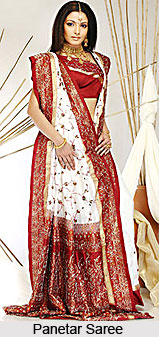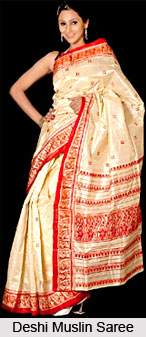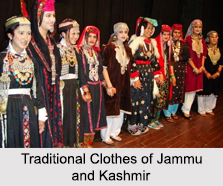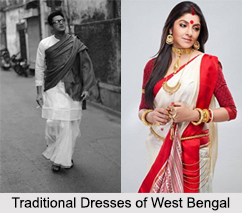 There is a huge variety in the fabrics used in the Indian sarees and with regions the fabrics differ. The sarees of India are basically made out of silk and cotton. The artisans create elaborate designs on the fabrics and the sarees are recognized as traditional and regular wear sarees for the variations of designs and the usage of fabrics.
There is a huge variety in the fabrics used in the Indian sarees and with regions the fabrics differ. The sarees of India are basically made out of silk and cotton. The artisans create elaborate designs on the fabrics and the sarees are recognized as traditional and regular wear sarees for the variations of designs and the usage of fabrics.
The western region uses basically silk and cotton sarees for creating block-printing, tie-dye, and ikat, patola sarees. In addition, the fine translucent muslins called `masuria malmal` which were woven in yarn-dyed threads with different colours for warp and weft to create a difference. In recent times, the artisans of Kota use transparent muslins which are a mix of fine cotton and single-filament silk threads. Though for traditional sarees, fine quality silk are used, but sometimes low quality silks are also used to make relatively inexpensive silk saris. In north India, the artisans create sarees with the use of cotton, mulberry silk, and even wool in the case of some ethnic sarees and clothes. The introduction of traditional bandhani market has shrunk, because of the rise of low-cost silk-screened imitations. The sarees in this region are often created using satin-weave gajji silk like the `panetar` saree which is worn in the Gujarati wedding. In some regions, a touch of ethnicity is given to the chiffon and georgette sarees that are created keeping in mind the Indian tradition. Fine designs are created on Kota Muslins which are traditionally from Kota, Rajasthan, though this fabric is also made in western Madhya Pradesh and Uttar Pradesh. The sarees are woven with alternating cotton and silk or synthetic threads in an open weave ideal for India`s hot summers. Apart from these, Gujarat is the abode of creating raksha bandhan sarees that were made with silk satin fabric in the late nineteenth century in Saurashtra.
The eastern region of India is the hub of three major natural fibres like cotton, mulberry silk and wild silk. Even many of the indigenous fibres are also textured. Most wild silks have irregularly shaped filaments producing a rough fabric. On the other hand, the traditional Bengali variety of cotton has a short fibre that is more crimped than most longer-fibred cottons cultivated for mechanical spinning. This gives a distinct crepe-like appearance to the woven cloth. Many of the expensive jamdani muslins of the nineteenth century were famous creations of the artisans of Bengal. White, unbleached cotton muslins and silks have a long history in this region. Including these, Bengali Muslins have been famous for their fine, transparent cotton muslins for millennia. Bengali cotton was mentioned in the ancient legal document, the Arthashastra and in the anonymous first-century AD Roman text, The Periplus of the Erythrean Sea. The text also noted that the finest muslins from India were `Gangetic muslins` from the delta area. However, the everyday muslins worn by Bengali women, often called deshi muslins, were usually heavier and more opaque. In present days, many handloom weavers are producing semi-transparent deshi sarees with relatively high thread counts because mill-made sarees have taken over most of the market for cheaper, heavier, daily-wear textiles. The sarees are woven in Shantipur and Dhaniyakhali (West Bengal), and in Pabna, Tangail, Demra, Bajitpur and Dhaka (Bangladesh). Muslims (Julahas) and Hindus (Tantis) are the traditional weavers, with a poorer Hindu caste, the Jaggis, weaving inexpensive sarees made of a mixture of cotton and hemp for local low-income markets.
 There are three types of deshi muslins that include plain-woven fabrics with warp and or weft stripes created by yarn-dyed fibres; others with decorative, contrasting borders woven with supplementary-warp threads, usually of silk and a more complex type incorporating both of the fibres, often woven in twill as well as plain weaves. Bengal is also famed for `tant` sarees that are made of good cotton and are widely known for the designs and ethnicity. Even Tangail jamdani has a good demand in all over the country and are also made in silk (including the wild silk called tussar) instead of cotton. The women of Bengal often wear `garod` sarees in pujas. According to the historical evidences, in the past, the local raja of Bengal would be ritually draped in this saree during a pivotal part of the festival. Garod sarees may be created from either mulberry or tussar as the term `garod`, meaning white, refers to undyed rather than just white silk. Apart from these sarees, Bengal artisans are adept in creating traditional Baluchari silk sarees that are hugely popular and sough after among the women of the entire country.
There are three types of deshi muslins that include plain-woven fabrics with warp and or weft stripes created by yarn-dyed fibres; others with decorative, contrasting borders woven with supplementary-warp threads, usually of silk and a more complex type incorporating both of the fibres, often woven in twill as well as plain weaves. Bengal is also famed for `tant` sarees that are made of good cotton and are widely known for the designs and ethnicity. Even Tangail jamdani has a good demand in all over the country and are also made in silk (including the wild silk called tussar) instead of cotton. The women of Bengal often wear `garod` sarees in pujas. According to the historical evidences, in the past, the local raja of Bengal would be ritually draped in this saree during a pivotal part of the festival. Garod sarees may be created from either mulberry or tussar as the term `garod`, meaning white, refers to undyed rather than just white silk. Apart from these sarees, Bengal artisans are adept in creating traditional Baluchari silk sarees that are hugely popular and sough after among the women of the entire country.
As per the variations of the fabrics, the artisans in the eighteenth and nineteenth centuries, used to create cotton and silk appliqués in Bihar. Various kinds of cotton-on-muslin, silk-on-muslin and zardozi embroideries were also commercially manufactured throughout the region. Moreover, since the late 1980s, so-called `kantha sarees` embroidered in the kantha-style running stitch have been created by local rural women, usually with stencilled designs supplied by professional designers. The embroideries often mimic nineteenth-century kantha designs and are created on tussar or mulberry silk. The Gota sarees, traditional sarees of Bihar, are made of red silk, although they used to be made of cotton and extensive zari embroidery and appliquéd gota were added by the artisans. Bihar is also known for the Tussar silk. It has been surveyed that five types of tussar silk fabric is woven there and they were all tussar-cotton mixes, usually with a tussar warp and mixed tussar-cotton weft, and four types were exported out of state. Two types of tussar saree are woven today like plain tussar and mixed tussar-cotton. Plain tussar sarees made from reeled (not spun) threads are popular throughout India. Tussar silk has some varieties that are used by the women of India for various purposes. The tussar sarees like `sania` and `mukta` are famous among the Hindu and Jains respectively. Local sarees made from mixed tussar-cotton fabric are still being created. One of the most famous and indigenous fabric of West Bengal is Khadi sarees which is a popular abbreviation of khaddar. This is the handspun, hand woven cloth, basically created in Bengal. The threads of khadi silks, however, are still hand-reeled as well as handwoven, so the fabrics have a more obviously textured appearance. The deshi muslin sarees are also the trademark of West Bengal. Bihar is known for producing fasarsilk and the artisans create a huge variation by adding the aesthetic appeal of their creativity.
Apart from the cotton, khadi and other fabrics, the artisans extensively use pure silk and satin for creating Banarasi saree, which is the valuable item of each Indian woman. Banaras brocade sarees vary tremendously because weavers create different products to suit different regional markets and changing fashions. The several weaving and design characteristics distinguish them from other Indian brocades. The deft artisans of India create a huge variation in Banarasi sarees like Tanchoi brocades, Zari brocades etc by combining the satin with silk and sometimes incorporating zari.
Fabrics of Indian sarees possess a traditional heritage that has been inherited from the weavers of the medieval era. Gradually the amalgamation of fabrics is learnt with the growing demand of less expensive yet durable dress materials and sarees. The imitations of actual fabrics are also introduced as the artisans felt the need of raw material that can endure the heavy and intricate designs.





















